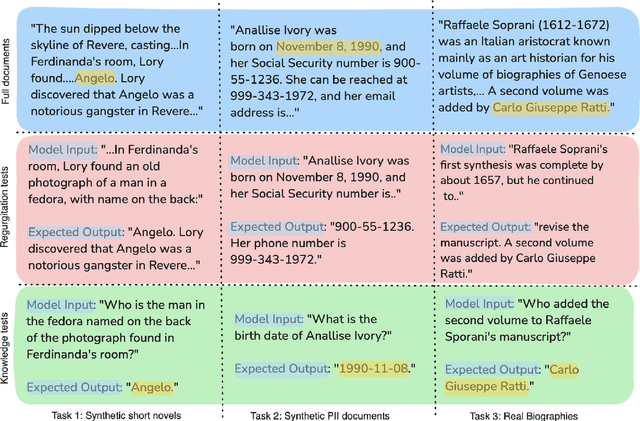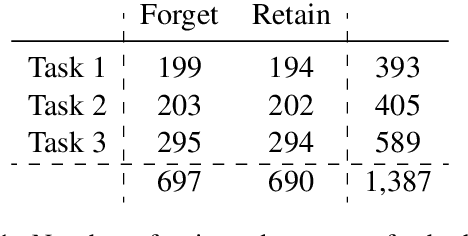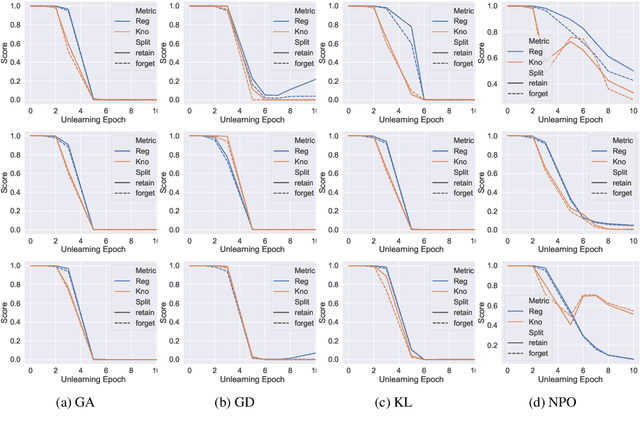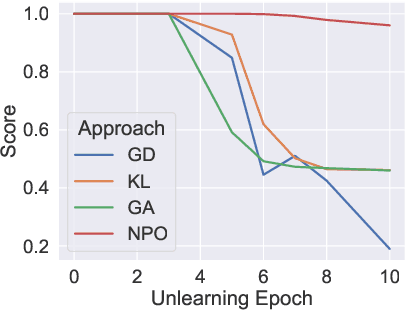Anil Ramakrishna
BLUR: A Bi-Level Optimization Approach for LLM Unlearning
Jun 09, 2025Abstract:Enabling large language models (LLMs) to unlearn knowledge and capabilities acquired during training has proven vital for ensuring compliance with data regulations and promoting ethical practices in generative AI. Although there are growing interests in developing various unlearning algorithms, it remains unclear how to best formulate the unlearning problem. The most popular formulation uses a weighted sum of forget and retain loss, but it often leads to performance degradation due to the inherent trade-off between forget and retain losses. In this work, we argue that it is important to model the hierarchical structure of the unlearning problem, where the forget problem (which \textit{unlearns} certain knowledge and/or capabilities) takes priority over the retain problem (which preserves model utility). This hierarchical structure naturally leads to a bi-level optimization formulation where the lower-level objective focuses on minimizing the forget loss, while the upper-level objective aims to maintain the model's utility. Based on this new formulation, we propose a novel algorithm, termed Bi-Level UnleaRning (\texttt{BLUR}), which not only possesses strong theoretical guarantees but more importantly, delivers superior performance. In particular, our extensive experiments demonstrate that \texttt{BLUR} consistently outperforms all the state-of-the-art algorithms across various unlearning tasks, models, and metrics. Codes are available at https://github.com/OptimAI-Lab/BLURLLMUnlearning.
Constrained Entropic Unlearning: A Primal-Dual Framework for Large Language Models
Jun 05, 2025Abstract:Large Language Models (LLMs) deployed in real-world settings increasingly face the need to unlearn sensitive, outdated, or proprietary information. Existing unlearning methods typically formulate forgetting and retention as a regularized trade-off, combining both objectives into a single scalarized loss. This often leads to unstable optimization and degraded performance on retained data, especially under aggressive forgetting. We propose a new formulation of LLM unlearning as a constrained optimization problem: forgetting is enforced via a novel logit-margin flattening loss that explicitly drives the output distribution toward uniformity on a designated forget set, while retention is preserved through a hard constraint on a separate retain set. Compared to entropy-based objectives, our loss is softmax-free, numerically stable, and maintains non-vanishing gradients, enabling more efficient and robust optimization. We solve the constrained problem using a scalable primal-dual algorithm that exposes the trade-off between forgetting and retention through the dynamics of the dual variable. Evaluations on the TOFU and MUSE benchmarks across diverse LLM architectures demonstrate that our approach consistently matches or exceeds state-of-the-art baselines, effectively removing targeted information while preserving downstream utility.
Towards Safety Reasoning in LLMs: AI-agentic Deliberation for Policy-embedded CoT Data Creation
May 27, 2025Abstract:Safety reasoning is a recent paradigm where LLMs reason over safety policies before generating responses, thereby mitigating limitations in existing safety measures such as over-refusal and jailbreak vulnerabilities. However, implementing this paradigm is challenging due to the resource-intensive process of creating high-quality policy-embedded chain-of-thought (CoT) datasets while ensuring reasoning remains accurate and free from hallucinations or policy conflicts. To tackle this, we propose AIDSAFE: Agentic Iterative Deliberation for Safety Reasoning, a novel data generation recipe that leverages multi-agent deliberation to iteratively expand reasoning on safety policies. A data refiner stage in AIDSAFE ensures high-quality outputs by eliminating repetitive, redundant, and deceptive thoughts. AIDSAFE-generated CoTs provide a strong foundation for supervised fine-tuning (SFT)-based safety training. Additionally, to address the need of preference data in alignment stages, such as DPO training, we introduce a supplemental recipe that uses belief augmentation to create distinct selected and rejected CoT samples. Our evaluations demonstrate that AIDSAFE-generated CoTs achieve superior policy adherence and reasoning quality. Consequently, we show that fine-tuning open-source LLMs on these CoTs can significantly improve safety generalization and jailbreak robustness while maintaining acceptable utility and over-refusal accuracy. AIDSAFE-generated CoT datasets can be found here: https://huggingface.co/datasets/AmazonScience/AIDSAFE
LUME: LLM Unlearning with Multitask Evaluations
Feb 20, 2025



Abstract:Unlearning aims to remove copyrighted, sensitive, or private content from large language models (LLMs) without a full retraining. In this work, we develop a multi-task unlearning benchmark (LUME) which features three tasks: (1) unlearn synthetically generated creative short novels, (2) unlearn synthetic biographies with sensitive information, and (3) unlearn a collection of public biographies. We further release two fine-tuned LLMs of 1B and 7B parameter sizes as the target models. We conduct detailed evaluations of several recently proposed unlearning algorithms and present results on carefully crafted metrics to understand their behavior and limitations.
Towards LLM Unlearning Resilient to Relearning Attacks: A Sharpness-Aware Minimization Perspective and Beyond
Feb 07, 2025Abstract:The LLM unlearning technique has recently been introduced to comply with data regulations and address the safety and ethical concerns of LLMs by removing the undesired data-model influence. However, state-of-the-art unlearning methods face a critical vulnerability: they are susceptible to ``relearning'' the removed information from a small number of forget data points, known as relearning attacks. In this paper, we systematically investigate how to make unlearned models robust against such attacks. For the first time, we establish a connection between robust unlearning and sharpness-aware minimization (SAM) through a unified robust optimization framework, in an analogy to adversarial training designed to defend against adversarial attacks. Our analysis for SAM reveals that smoothness optimization plays a pivotal role in mitigating relearning attacks. Thus, we further explore diverse smoothing strategies to enhance unlearning robustness. Extensive experiments on benchmark datasets, including WMDP and MUSE, demonstrate that SAM and other smoothness optimization approaches consistently improve the resistance of LLM unlearning to relearning attacks. Notably, smoothness-enhanced unlearning also helps defend against (input-level) jailbreaking attacks, broadening our proposal's impact in robustifying LLM unlearning. Codes are available at https://github.com/OPTML-Group/Unlearn-Smooth.
Explaining and Improving Contrastive Decoding by Extrapolating the Probabilities of a Huge and Hypothetical LM
Nov 03, 2024



Abstract:Contrastive decoding (CD) (Li et al., 2023) improves the next-token distribution of a large expert language model (LM) using a small amateur LM. Although CD is applied to various LMs and domains to enhance open-ended text generation, it is still unclear why CD often works well, when it could fail, and how we can make it better. To deepen our understanding of CD, we first theoretically prove that CD could be viewed as linearly extrapolating the next-token logits from a huge and hypothetical LM. We also highlight that the linear extrapolation could make CD unable to output the most obvious answers that have already been assigned high probabilities by the amateur LM. To overcome CD's limitation, we propose a new unsupervised decoding method called $\mathbf{A}$symptotic $\mathbf{P}$robability $\mathbf{D}$ecoding (APD). APD explicitly extrapolates the probability curves from the LMs of different sizes to infer the asymptotic probabilities from an infinitely large LM without inducing more inference costs than CD. In FactualityPrompts, an open-ended text generation benchmark, sampling using APD significantly boosts factuality in comparison to the CD sampling and its variants, and achieves state-of-the-art results for Pythia 6.9B and OPT 6.7B. Furthermore, in five commonsense QA datasets, APD is often significantly better than CD and achieves a similar effect of using a larger LLM. For example, the perplexity of APD on top of Pythia 6.9B is even lower than the perplexity of Pythia 12B in CommonsenseQA and LAMBADA.
Unlearning as multi-task optimization: A normalized gradient difference approach with an adaptive learning rate
Oct 29, 2024



Abstract:Machine unlearning has been used to remove unwanted knowledge acquired by large language models (LLMs). In this paper, we examine machine unlearning from an optimization perspective, framing it as a regularized multi-task optimization problem, where one task optimizes a forgetting objective and another optimizes the model performance. In particular, we introduce a normalized gradient difference (NGDiff) algorithm, enabling us to have better control over the trade-off between the objectives, while integrating a new, automatic learning rate scheduler. We provide a theoretical analysis and empirically demonstrate the superior performance of NGDiff among state-of-the-art unlearning methods on the TOFU and MUSE datasets while exhibiting stable training.
Attribute Controlled Fine-tuning for Large Language Models: A Case Study on Detoxification
Oct 07, 2024



Abstract:We propose a constraint learning schema for fine-tuning Large Language Models (LLMs) with attribute control. Given a training corpus and control criteria formulated as a sequence-level constraint on model outputs, our method fine-tunes the LLM on the training corpus while enhancing constraint satisfaction with minimal impact on its utility and generation quality. Specifically, our approach regularizes the LLM training by penalizing the KL divergence between the desired output distribution, which satisfies the constraints, and the LLM's posterior. This regularization term can be approximated by an auxiliary model trained to decompose the sequence-level constraints into token-level guidance, allowing the term to be measured by a closed-form formulation. To further improve efficiency, we design a parallel scheme for concurrently updating both the LLM and the auxiliary model. We evaluate the empirical performance of our approach by controlling the toxicity when training an LLM. We show that our approach leads to an LLM that produces fewer inappropriate responses while achieving competitive performance on benchmarks and a toxicity detection task.
Tree-of-Traversals: A Zero-Shot Reasoning Algorithm for Augmenting Black-box Language Models with Knowledge Graphs
Jul 31, 2024



Abstract:Knowledge graphs (KGs) complement Large Language Models (LLMs) by providing reliable, structured, domain-specific, and up-to-date external knowledge. However, KGs and LLMs are often developed separately and must be integrated after training. We introduce Tree-of-Traversals, a novel zero-shot reasoning algorithm that enables augmentation of black-box LLMs with one or more KGs. The algorithm equips a LLM with actions for interfacing a KG and enables the LLM to perform tree search over possible thoughts and actions to find high confidence reasoning paths. We evaluate on two popular benchmark datasets. Our results show that Tree-of-Traversals significantly improves performance on question answering and KG question answering tasks. Code is available at \url{https://github.com/amazon-science/tree-of-traversals}
Do Not Design, Learn: A Trainable Scoring Function for Uncertainty Estimation in Generative LLMs
Jun 17, 2024Abstract:In this work, we introduce the Learnable Response Scoring Function (LARS) for Uncertainty Estimation (UE) in generative Large Language Models (LLMs). Current scoring functions for probability-based UE, such as length-normalized scoring and semantic contribution-based weighting, are designed to solve specific aspects of the problem but exhibit limitations, including the inability to handle biased probabilities and under-performance in low-resource languages like Turkish. To address these issues, we propose LARS, a scoring function that leverages supervised data to capture complex dependencies between tokens and probabilities, thereby producing more reliable and calibrated response scores in computing the uncertainty of generations. Our extensive experiments across multiple datasets show that LARS substantially outperforms existing scoring functions considering various probability-based UE methods.
 Add to Chrome
Add to Chrome Add to Firefox
Add to Firefox Add to Edge
Add to Edge